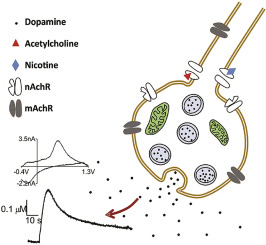Neurochemistry international ( IF 4.2 ) Pub Date : 2018-01-03 , DOI: 10.1016/j.neuint.2017.12.012 Poojan Pyakurel , Mimi Shin , B. Jill Venton

|
Acetylcholine is an excitatory neurotransmitter in the central nervous system of insects and the nicotinic acetylcholine receptor (nAChR) is a target for neonicotinoid insecticides. Functional insect nAChRs are difficult to express in host cells, and hence difficult to study. In mammals, acetylcholine and nicotine evoke dopamine release, but the extent to which this mechanism is conserved in insects is unknown. In intact larval ventral nerve cords (VNCs), we studied dopamine evoked by acetylcholine, nicotine, or neonicotinoids. Using fast-scan cyclic voltammetry, we confirmed dopamine was measured by its cyclic voltammogram and also by feeding Drosophila the synthesis inhibitor, 3-iodotyrosine, which lowered the evoked dopamine response. Acetylcholine (1.8 pmol) evoked on average 0.43 ± 0.04 μM dopamine. Dopamine release significantly decreased after incubation with α-bungarotoxin, demonstrating the release is mediated by nAChR, but atropine, a muscarinic AChR antagonist, had no effect. Nicotine (t1/2 = 71 s) and the neonicotinoids nitenpyram and imidacloprid (t1/2 = 86 s, 121 s respectively) also evoked dopamine release, which lasted longer than acetylcholine-stimulated release (t1/2 = 19 s). Nicotine-stimulated dopamine was significantly lower in the presence of sodium channel blocker, tetrodotoxin, showing that the release is exocytotic. Drosophila that have mutations in the nAChR subunit α1 or β2 have significantly lower neonicotinoid-stimulated release but no changes in nicotine-stimulated release. This work demonstrates that nAChR agonists mediate dopamine release in Drosophila larval VNC and that mutations in nAChR subunits affect how insecticides stimulate dopamine release.
中文翻译:

烟碱乙酰胆碱受体(nAChR)介导的黑腹果蝇幼虫中的多巴胺释放
乙酰胆碱是昆虫中枢神经系统中的一种兴奋性神经递质,而烟碱乙酰胆碱受体(nAChR)是新烟碱类杀虫剂的目标。功能性昆虫nAChRs难以在宿主细胞中表达,因此难以研究。在哺乳动物中,乙酰胆碱和尼古丁会引起多巴胺释放,但是这种机制在昆虫中的保守程度尚不清楚。在完整的幼虫腹侧神经索(VNC)中,我们研究了乙酰胆碱,尼古丁或新烟碱诱发的多巴胺。使用快速扫描循环伏安法,我们证实多巴胺可以通过其循环伏安图以及果蝇的摄食来测量合成抑制剂3-碘酪氨酸可降低诱发的多巴胺反应。乙酰胆碱(1.8 pmol)诱发的平均多巴胺含量为0.43±0.04μM。与α-真菌毒素孵育后,多巴胺释放显着降低,表明该释放是由nAChR介导的,但毒蕈碱AChR拮抗剂阿托品没有作用。尼古丁(t 1/2 = 71 s)和新烟碱类乙炔吡虫酯和吡虫啉(分别为t 1/2 = 86 s,121 s)也引起多巴胺释放,其持续时间比乙酰胆碱刺激的释放持续时间(t 1/2 = 19 s) )。在钠通道阻滞剂河豚毒素的存在下,尼古丁刺激的多巴胺明显降低,表明释放是胞吐的。果蝇那些在nAChR亚基α1或β2中发生突变的人,其新烟碱样刺激的释放明显降低,而尼古丁样刺激的释放则没有变化。这项工作表明,nAChR激动剂介导果蝇幼虫VNC中的多巴胺释放,并且nAChR亚基中的突变影响杀虫剂刺激多巴胺释放的方式。



























 京公网安备 11010802027423号
京公网安备 11010802027423号